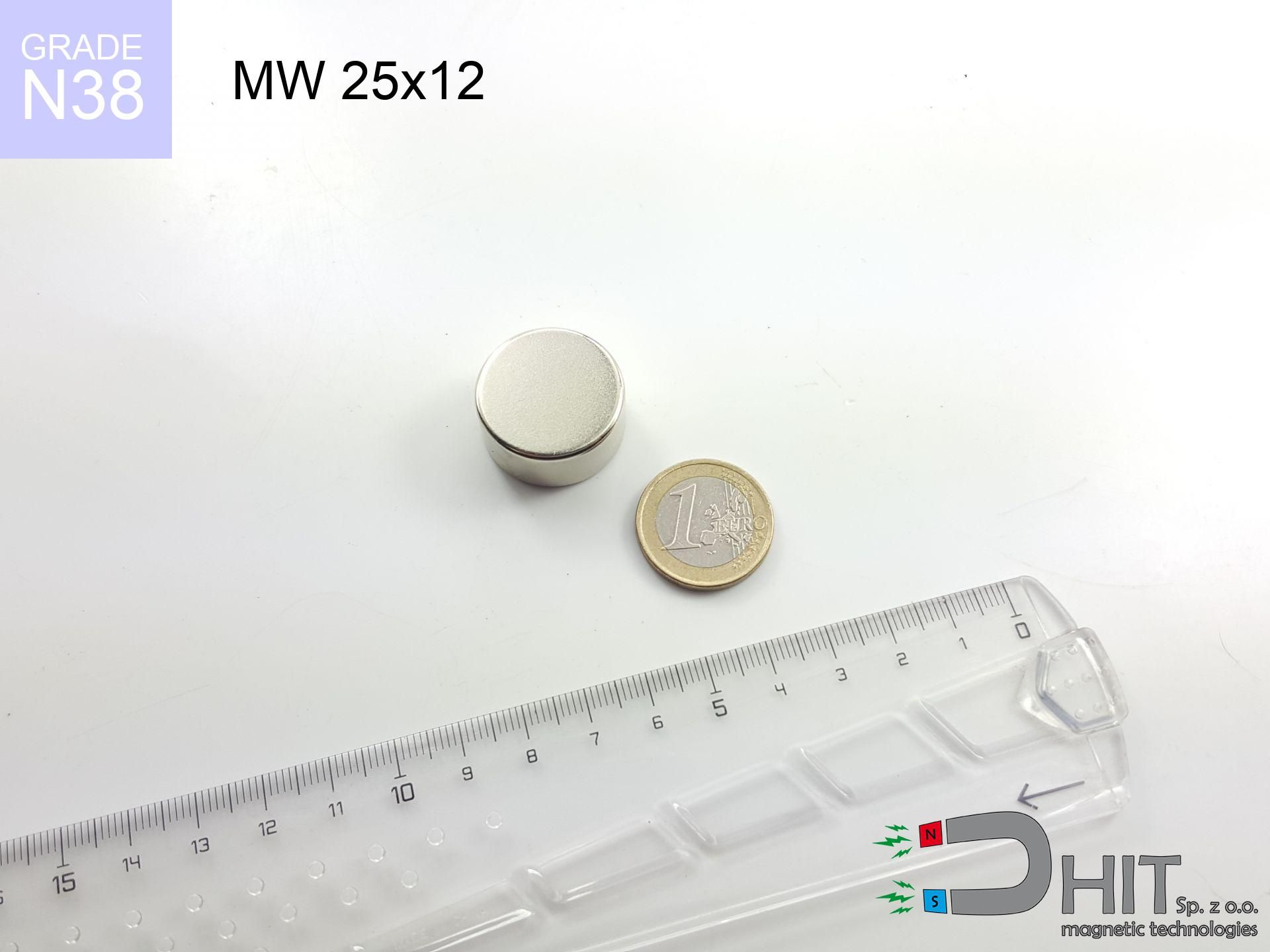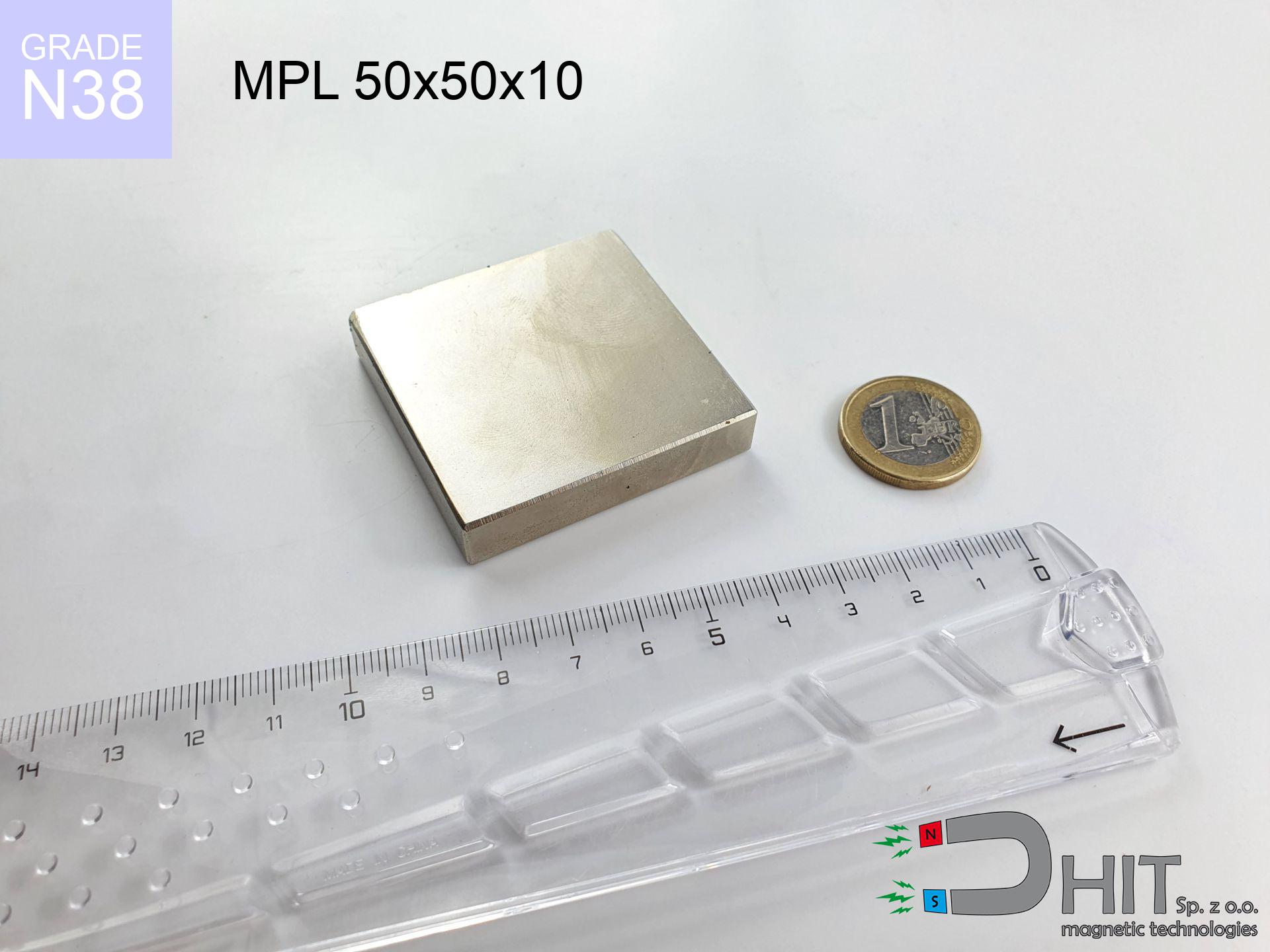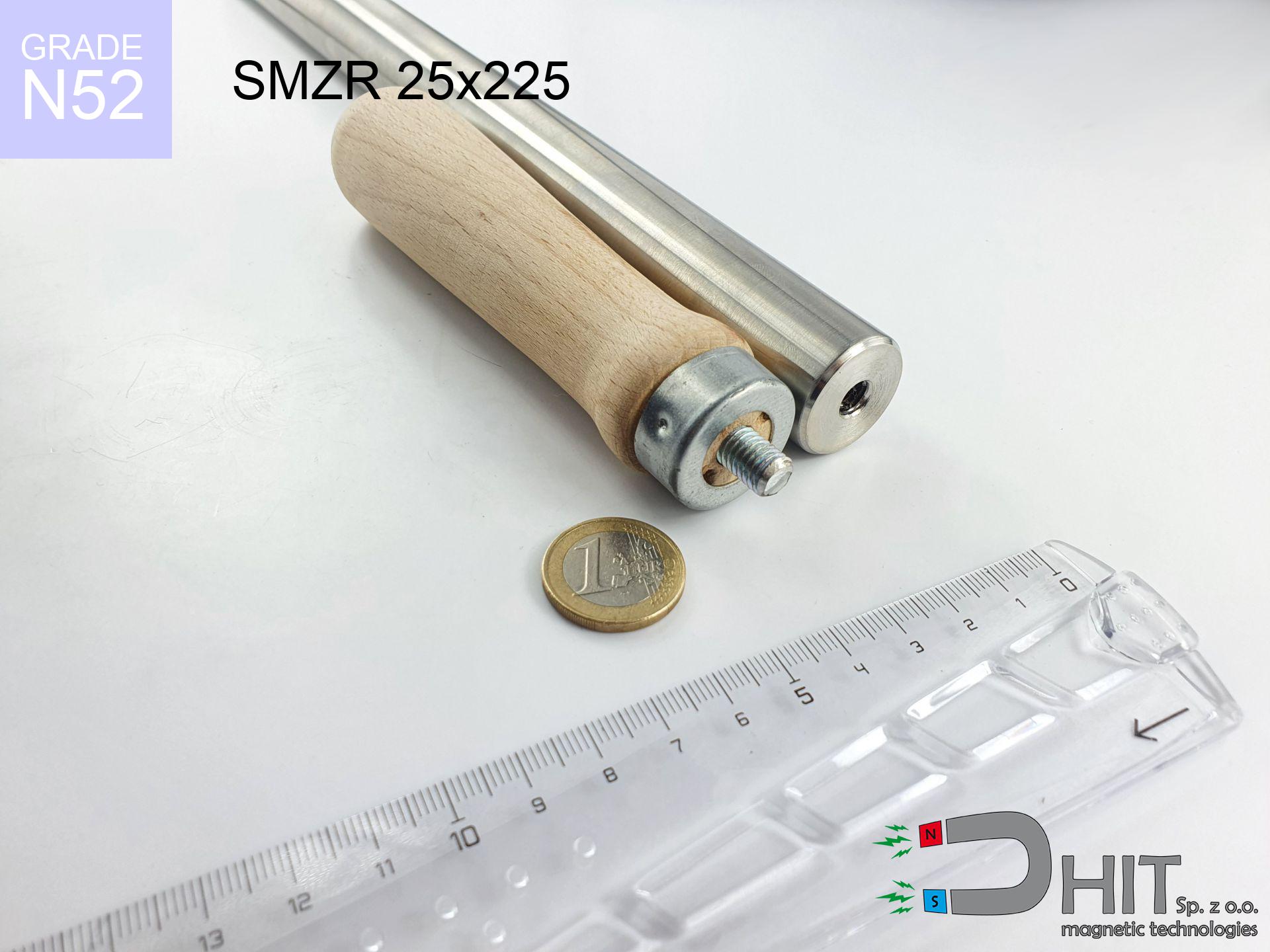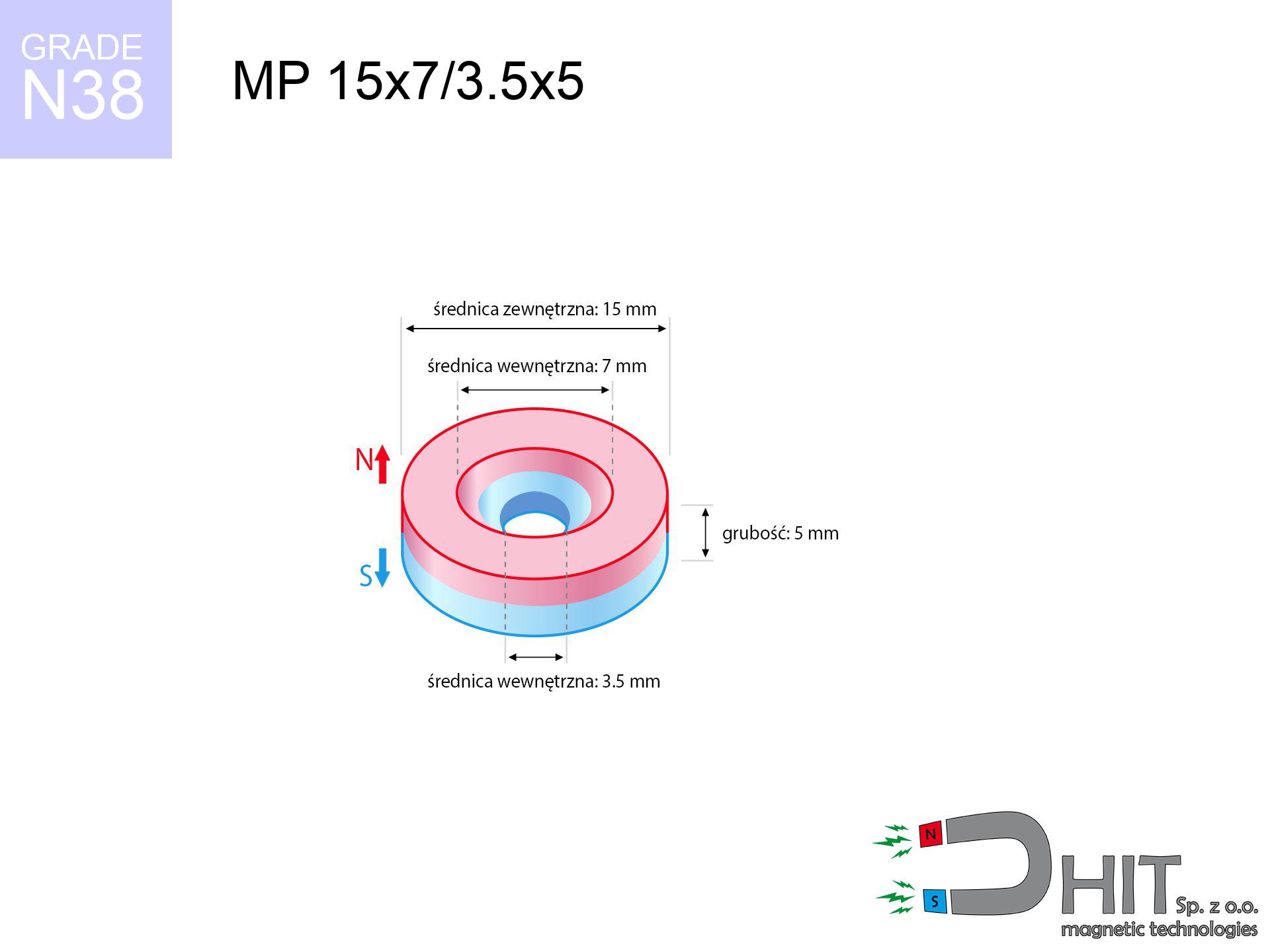MW 25x12 / N38 - cylindrical magnet
cylindrical magnet
Catalog no 010502
GTIN/EAN: 5906301814986
Diameter Ø
25 mm [±0,1 mm]
Height
12 mm [±0,1 mm]
Weight
44.18 g
Magnetization Direction
↑ axial
Load capacity
19.60 kg / 192.25 N
Magnetic Induction
429.18 mT / 4292 Gs
Coating
[NiCuNi] Nickel
16.64 ZŁ with VAT / pcs + price for transport
13.53 ZŁ net + 23% VAT / pcs
bulk discounts:
Need more?
Give us a call
+48 22 499 98 98
otherwise send us a note through
request form
the contact section.
Strength along with shape of magnets can be tested using our
modular calculator.
Same-day shipping for orders placed before 14:00.
Technical details - MW 25x12 / N38 - cylindrical magnet
Specification / characteristics - MW 25x12 / N38 - cylindrical magnet
| properties | values |
|---|---|
| Cat. no. | 010502 |
| GTIN/EAN | 5906301814986 |
| Production/Distribution | Dhit sp. z o.o. |
| Country of origin | Poland / China / Germany |
| Customs code | 85059029 |
| Diameter Ø | 25 mm [±0,1 mm] |
| Height | 12 mm [±0,1 mm] |
| Weight | 44.18 g |
| Magnetization Direction | ↑ axial |
| Load capacity ~ ? | 19.60 kg / 192.25 N |
| Magnetic Induction ~ ? | 429.18 mT / 4292 Gs |
| Coating | [NiCuNi] Nickel |
| Manufacturing Tolerance | ±0.1 mm |
Magnetic properties of material N38
| properties | values | units |
|---|---|---|
| remenance Br [min. - max.] ? | 12.2-12.6 | kGs |
| remenance Br [min. - max.] ? | 1220-1260 | mT |
| coercivity bHc ? | 10.8-11.5 | kOe |
| coercivity bHc ? | 860-915 | kA/m |
| actual internal force iHc | ≥ 12 | kOe |
| actual internal force iHc | ≥ 955 | kA/m |
| energy density [min. - max.] ? | 36-38 | BH max MGOe |
| energy density [min. - max.] ? | 287-303 | BH max KJ/m |
| max. temperature ? | ≤ 80 | °C |
Physical properties of sintered neodymium magnets Nd2Fe14B at 20°C
| properties | values | units |
|---|---|---|
| Vickers hardness | ≥550 | Hv |
| Density | ≥7.4 | g/cm3 |
| Curie Temperature TC | 312 - 380 | °C |
| Curie Temperature TF | 593 - 716 | °F |
| Specific resistance | 150 | μΩ⋅cm |
| Bending strength | 250 | MPa |
| Compressive strength | 1000~1100 | MPa |
| Thermal expansion parallel (∥) to orientation (M) | (3-4) x 10-6 | °C-1 |
| Thermal expansion perpendicular (⊥) to orientation (M) | -(1-3) x 10-6 | °C-1 |
| Young's modulus | 1.7 x 104 | kg/mm² |
Engineering simulation of the assembly - data
Presented values are the result of a physical simulation. Results rely on models for the class Nd2Fe14B. Actual parameters might slightly differ from theoretical values. Use these calculations as a supplementary guide for designers.
Table 1: Static force (force vs gap) - interaction chart
MW 25x12 / N38
| Distance (mm) | Induction (Gauss) / mT | Pull Force (kg) | Risk Status |
|---|---|---|---|
| 0 mm |
4291 Gs
429.1 mT
|
19.60 kg / 19600.0 g
192.3 N
|
dangerous! |
| 1 mm |
3975 Gs
397.5 mT
|
16.82 kg / 16820.5 g
165.0 N
|
dangerous! |
| 2 mm |
3645 Gs
364.5 mT
|
14.15 kg / 14147.5 g
138.8 N
|
dangerous! |
| 3 mm |
3316 Gs
331.6 mT
|
11.71 kg / 11707.5 g
114.9 N
|
dangerous! |
| 5 mm |
2692 Gs
269.2 mT
|
7.72 kg / 7718.0 g
75.7 N
|
strong |
| 10 mm |
1518 Gs
151.8 mT
|
2.45 kg / 2451.8 g
24.1 N
|
strong |
| 15 mm |
863 Gs
86.3 mT
|
0.79 kg / 793.5 g
7.8 N
|
safe |
| 20 mm |
517 Gs
51.7 mT
|
0.29 kg / 285.1 g
2.8 N
|
safe |
| 30 mm |
219 Gs
21.9 mT
|
0.05 kg / 51.2 g
0.5 N
|
safe |
| 50 mm |
63 Gs
6.3 mT
|
0.00 kg / 4.2 g
0.0 N
|
safe |
Table 2: Slippage capacity (vertical surface)
MW 25x12 / N38
| Distance (mm) | Friction coefficient | Pull Force (kg) |
|---|---|---|
| 0 mm | Stal (~0.2) |
3.92 kg / 3920.0 g
38.5 N
|
| 1 mm | Stal (~0.2) |
3.36 kg / 3364.0 g
33.0 N
|
| 2 mm | Stal (~0.2) |
2.83 kg / 2830.0 g
27.8 N
|
| 3 mm | Stal (~0.2) |
2.34 kg / 2342.0 g
23.0 N
|
| 5 mm | Stal (~0.2) |
1.54 kg / 1544.0 g
15.1 N
|
| 10 mm | Stal (~0.2) |
0.49 kg / 490.0 g
4.8 N
|
| 15 mm | Stal (~0.2) |
0.16 kg / 158.0 g
1.5 N
|
| 20 mm | Stal (~0.2) |
0.06 kg / 58.0 g
0.6 N
|
| 30 mm | Stal (~0.2) |
0.01 kg / 10.0 g
0.1 N
|
| 50 mm | Stal (~0.2) |
0.00 kg / 0.0 g
0.0 N
|
Table 3: Wall mounting (sliding) - vertical pull
MW 25x12 / N38
| Surface type | Friction coefficient / % Mocy | Max load (kg) |
|---|---|---|
| Raw steel |
µ = 0.3
30% Nominalnej Siły
|
5.88 kg / 5880.0 g
57.7 N
|
| Painted steel (standard) |
µ = 0.2
20% Nominalnej Siły
|
3.92 kg / 3920.0 g
38.5 N
|
| Oily/slippery steel |
µ = 0.1
10% Nominalnej Siły
|
1.96 kg / 1960.0 g
19.2 N
|
| Magnet with anti-slip rubber |
µ = 0.5
50% Nominalnej Siły
|
9.80 kg / 9800.0 g
96.1 N
|
Table 4: Material efficiency (saturation) - power losses
MW 25x12 / N38
| Steel thickness (mm) | % power | Real pull force (kg) |
|---|---|---|
| 0.5 mm |
|
0.98 kg / 980.0 g
9.6 N
|
| 1 mm |
|
2.45 kg / 2450.0 g
24.0 N
|
| 2 mm |
|
4.90 kg / 4900.0 g
48.1 N
|
| 5 mm |
|
12.25 kg / 12250.0 g
120.2 N
|
| 10 mm |
|
19.60 kg / 19600.0 g
192.3 N
|
Table 5: Working in heat (stability) - resistance threshold
MW 25x12 / N38
| Ambient temp. (°C) | Power loss | Remaining pull | Status |
|---|---|---|---|
| 20 °C | 0.0% |
19.60 kg / 19600.0 g
192.3 N
|
OK |
| 40 °C | -2.2% |
19.17 kg / 19168.8 g
188.0 N
|
OK |
| 60 °C | -4.4% |
18.74 kg / 18737.6 g
183.8 N
|
|
| 80 °C | -6.6% |
18.31 kg / 18306.4 g
179.6 N
|
|
| 100 °C | -28.8% |
13.96 kg / 13955.2 g
136.9 N
|
Table 6: Two magnets (repulsion) - forces in the system
MW 25x12 / N38
| Gap (mm) | Attraction (kg) (N-S) | Repulsion (kg) (N-N) |
|---|---|---|
| 0 mm |
55.71 kg / 55711 g
546.5 N
5 494 Gs
|
N/A |
| 1 mm |
51.78 kg / 51775 g
507.9 N
8 273 Gs
|
46.60 kg / 46598 g
457.1 N
~0 Gs
|
| 2 mm |
47.81 kg / 47810 g
469.0 N
7 949 Gs
|
43.03 kg / 43029 g
422.1 N
~0 Gs
|
| 3 mm |
43.94 kg / 43944 g
431.1 N
7 621 Gs
|
39.55 kg / 39549 g
388.0 N
~0 Gs
|
| 5 mm |
36.65 kg / 36650 g
359.5 N
6 960 Gs
|
32.98 kg / 32985 g
323.6 N
~0 Gs
|
| 10 mm |
21.94 kg / 21938 g
215.2 N
5 385 Gs
|
19.74 kg / 19744 g
193.7 N
~0 Gs
|
| 20 mm |
6.97 kg / 6969 g
68.4 N
3 035 Gs
|
6.27 kg / 6272 g
61.5 N
~0 Gs
|
| 50 mm |
0.33 kg / 326 g
3.2 N
657 Gs
|
0.29 kg / 294 g
2.9 N
~0 Gs
|
Table 7: Hazards (electronics) - warnings
MW 25x12 / N38
| Object / Device | Limit (Gauss) / mT | Safe distance |
|---|---|---|
| Pacemaker | 5 Gs (0.5 mT) | 13.0 cm |
| Hearing aid | 10 Gs (1.0 mT) | 10.0 cm |
| Mechanical watch | 20 Gs (2.0 mT) | 8.0 cm |
| Phone / Smartphone | 40 Gs (4.0 mT) | 6.0 cm |
| Remote | 50 Gs (5.0 mT) | 5.5 cm |
| Payment card | 400 Gs (40.0 mT) | 2.5 cm |
| HDD hard drive | 600 Gs (60.0 mT) | 2.0 cm |
Table 8: Collisions (cracking risk) - collision effects
MW 25x12 / N38
| Start from (mm) | Speed (km/h) | Energy (J) | Predicted outcome |
|---|---|---|---|
| 10 mm |
22.84 km/h
(6.35 m/s)
|
0.89 J | |
| 30 mm |
36.85 km/h
(10.24 m/s)
|
2.31 J | |
| 50 mm |
47.51 km/h
(13.20 m/s)
|
3.85 J | |
| 100 mm |
67.17 km/h
(18.66 m/s)
|
7.69 J |
Table 9: Corrosion resistance
MW 25x12 / N38
| Technical parameter | Value / Description |
|---|---|
| Coating type | [NiCuNi] Nickel |
| Layer structure | Nickel - Copper - Nickel |
| Layer thickness | 10-20 µm |
| Salt spray test (SST) ? | 24 h |
| Recommended environment | Indoors only (dry) |
Table 10: Electrical data (Pc)
MW 25x12 / N38
| Parameter | Value | SI Unit / Description |
|---|---|---|
| Magnetic Flux | 21 413 Mx | 214.1 µWb |
| Pc Coefficient | 0.57 | Low (Flat) |
Table 11: Physics of underwater searching
MW 25x12 / N38
| Environment | Effective steel pull | Effect |
|---|---|---|
| Air (land) | 19.60 kg | Standard |
| Water (riverbed) |
22.44 kg
(+2.84 kg Buoyancy gain)
|
+14.5% |
1. Shear force
*Caution: On a vertical surface, the magnet holds merely ~20% of its nominal pull.
2. Steel saturation
*Thin steel (e.g. 0.5mm PC case) significantly reduces the holding force.
3. Heat tolerance
*For N38 material, the max working temp is 80°C.
4. Demagnetization curve and operating point (B-H)
chart generated for the permeance coefficient Pc (Permeance Coefficient) = 0.57
This simulation demonstrates the magnetic stability of the selected magnet under specific geometric conditions. The solid red line represents the demagnetization curve (material potential), while the dashed blue line is the load line based on the magnet's geometry. The Pc (Permeance Coefficient), also known as the load line slope, is a dimensionless value that describes the relationship between the magnet's shape and its magnetic stability. The intersection of these two lines (the black dot) is the operating point — it determines the actual magnetic flux density generated by the magnet in this specific configuration. A higher Pc value means the magnet is more 'slender' (tall relative to its area), resulting in a higher operating point and better resistance to irreversible demagnetization caused by external fields or temperature. A value of 0.42 is relatively low (typical for flat magnets), meaning the operating point is closer to the 'knee' of the curve — caution is advised when operating at temperatures near the maximum limit to avoid strength loss.
Elemental analysis
| iron (Fe) | 64% – 68% |
| neodymium (Nd) | 29% – 32% |
| boron (B) | 1.1% – 1.2% |
| dysprosium (Dy) | 0.5% – 2.0% |
| coating (Ni-Cu-Ni) | < 0.05% |
Ecology and recycling (GPSR)
| recyclability (EoL) | 100% |
| recycled raw materials | ~10% (pre-cons) |
| carbon footprint | low / zredukowany |
| waste code (EWC) | 16 02 16 |
Other proposals
Advantages and disadvantages of neodymium magnets.
Advantages
- They virtually do not lose strength, because even after ten years the decline in efficiency is only ~1% (based on calculations),
- Magnets perfectly defend themselves against demagnetization caused by ambient magnetic noise,
- By using a shiny coating of gold, the element has an elegant look,
- Magnets possess excellent magnetic induction on the working surface,
- Neodymium magnets are characterized by extremely high magnetic induction on the magnet surface and can work (depending on the form) even at a temperature of 230°C or more...
- In view of the ability of accurate molding and customization to unique requirements, neodymium magnets can be manufactured in a broad palette of forms and dimensions, which makes them more universal,
- Key role in future technologies – they are commonly used in magnetic memories, electric drive systems, medical devices, as well as industrial machines.
- Thanks to their power density, small magnets offer high operating force, in miniature format,
Disadvantages
- Susceptibility to cracking is one of their disadvantages. Upon intense impact they can fracture. We advise keeping them in a steel housing, which not only secures them against impacts but also increases their durability
- Neodymium magnets decrease their strength under the influence of heating. As soon as 80°C is exceeded, many of them start losing their force. Therefore, we recommend our special magnets marked [AH], which maintain durability even at temperatures up to 230°C
- They oxidize in a humid environment - during use outdoors we advise using waterproof magnets e.g. in rubber, plastic
- We recommend casing - magnetic mechanism, due to difficulties in producing nuts inside the magnet and complex forms.
- Health risk resulting from small fragments of magnets are risky, in case of ingestion, which gains importance in the context of child safety. Furthermore, small elements of these devices are able to disrupt the diagnostic process medical in case of swallowing.
- High unit price – neodymium magnets have a higher price than other types of magnets (e.g. ferrite), which increases costs of application in large quantities
Pull force analysis
Highest magnetic holding force – what contributes to it?
- with the contact of a yoke made of low-carbon steel, ensuring maximum field concentration
- whose thickness is min. 10 mm
- characterized by even structure
- without the slightest air gap between the magnet and steel
- under perpendicular force direction (90-degree angle)
- at conditions approx. 20°C
Determinants of practical lifting force of a magnet
- Air gap (betwixt the magnet and the plate), as even a very small clearance (e.g. 0.5 mm) leads to a reduction in lifting capacity by up to 50% (this also applies to paint, rust or debris).
- Force direction – note that the magnet has greatest strength perpendicularly. Under shear forces, the capacity drops drastically, often to levels of 20-30% of the maximum value.
- Element thickness – for full efficiency, the steel must be adequately massive. Paper-thin metal restricts the attraction force (the magnet "punches through" it).
- Material type – ideal substrate is pure iron steel. Hardened steels may have worse magnetic properties.
- Surface finish – ideal contact is possible only on smooth steel. Rough texture create air cushions, reducing force.
- Thermal factor – high temperature weakens magnetic field. Too high temperature can permanently demagnetize the magnet.
Lifting capacity testing was carried out on a smooth plate of suitable thickness, under a perpendicular pulling force, however under parallel forces the load capacity is reduced by as much as 5 times. Moreover, even a minimal clearance between the magnet and the plate lowers the lifting capacity.
Safety rules for work with NdFeB magnets
Finger safety
Pinching hazard: The pulling power is so immense that it can cause hematomas, crushing, and broken bones. Use thick gloves.
Choking Hazard
NdFeB magnets are not intended for children. Accidental ingestion of a few magnets may result in them attracting across intestines, which poses a direct threat to life and requires immediate surgery.
Shattering risk
Despite metallic appearance, the material is delicate and not impact-resistant. Do not hit, as the magnet may shatter into sharp, dangerous pieces.
Warning for heart patients
Warning for patients: Strong magnetic fields disrupt medical devices. Maintain at least 30 cm distance or ask another person to handle the magnets.
Data carriers
Intense magnetic fields can destroy records on payment cards, hard drives, and storage devices. Keep a distance of min. 10 cm.
Impact on smartphones
Be aware: rare earth magnets generate a field that disrupts precision electronics. Keep a safe distance from your mobile, device, and GPS.
Demagnetization risk
Monitor thermal conditions. Heating the magnet to high heat will permanently weaken its magnetic structure and pulling force.
Combustion hazard
Fire warning: Neodymium dust is highly flammable. Do not process magnets in home conditions as this may cause fire.
Allergy Warning
Medical facts indicate that nickel (the usual finish) is a strong allergen. For allergy sufferers, refrain from touching magnets with bare hands and select coated magnets.
Safe operation
Before starting, read the rules. Uncontrolled attraction can destroy the magnet or injure your hand. Think ahead.








